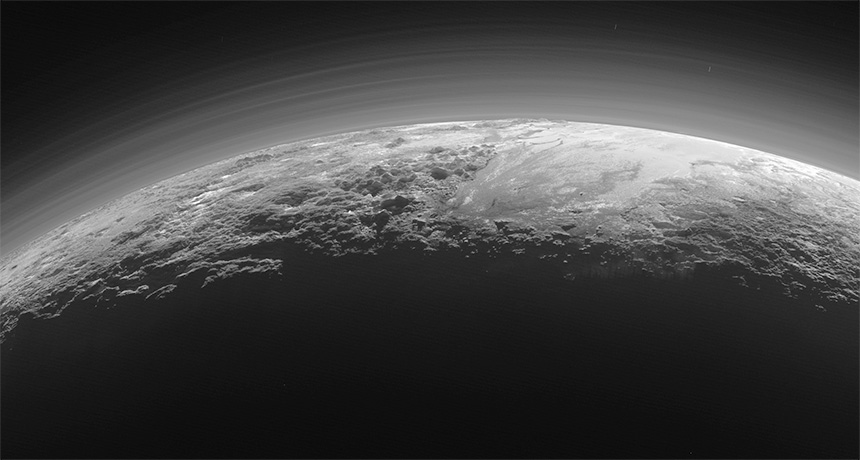How Pluto’s haze could explain its red spots

Pluto may get its smattering of red spots from the fallout of its hazy blue skies, researchers say.
Haze particles from the dwarf planet’s atmosphere settle onto all of Pluto’s surfaces. But some regions may become redder and darker than others because parts of the atmosphere collapse, exposing those spots to more surface-darkening radiation from space, researchers report March 22 at the Lunar and Planetary Science Conference in The Woodlands, Texas.
“The atmospheric haze on Pluto was a spectacular surprise,” says NASA New Horizons mission scientist Andrew Cheng, a physicist at Johns Hopkins University. When the New Horizons spacecraft flew past Pluto in 2015, scientists weren’t expecting to see haze reaching at least 200 kilometers above the dwarf planet’s surface; nor were they expecting to see the haze divided into about 20 delicate and distinct layers (SN Online: 10/15/15).
These discoveries led researchers to suspect that the layers formed as a result of weak winds blowing across Pluto’s surface and over its mountains. Cheng and colleagues describe how the winds would shape the haze layers in a paper accepted in Icarus and posted online February 24 at arXiv.org. The team also explains how the atmosphere may affect the color of the dwarf planet’s surface features.
“Haze particles continually fall out onto the surface and rapidly build up,” Cheng says. This process should effectively “paint” the entire surface a uniform color — but Pluto isn’t a single color. It has strikingly bright and dark terrains, with some of the highest contrast found in the solar system. These dark and light regions form because portions of Pluto’s atmosphere periodically collapse, with air freezing and falling onto the dwarf planet’s surface, he and colleagues suggest.
When a section of the atmosphere collapses, parts of the surface are exposed directly to radiation from space, which would darken the surface particles there, Cheng explains. The richness of the reds, the team says, cannot be explained without some kind of collapse of the atmosphere, which does eventually redevelop.
Observations from NASA’s Kepler spacecraft also support the idea that Pluto’s atmosphere collapses. In fact, as Pluto moves away from the sun, most, if not all, of its atmosphere may collapse onto the dwarf planet’s surface, reported Carey Lisse, also of Johns Hopkins University, at the conference.
Exactly how much of Pluto’s atmosphere freezes out during its year, which lasts for 248 Earth years, isn’t clear. But that is currently being monitored, says Timothy Dowling, an atmospheric scientist at the University of Louisville in Kentucky, who was not involved in the new work. Pluto, he notes, won’t complete the first lap that humans have watched it make around the sun until 2178.